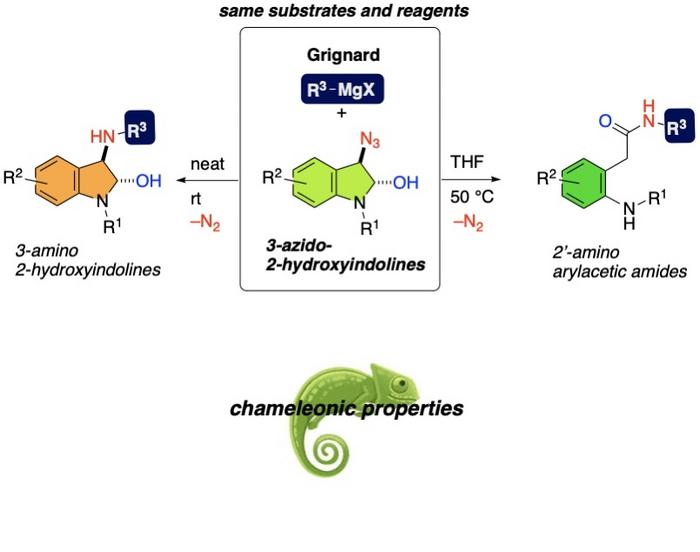Aniline or nitrogen-containing organic molecules like 3-aniline-substituted indoles commonly found in natural products have shown promising results as pharmaceutical contenders. The same goes for moieties such as 2-aminoaryl acetic acid scaffold which forms the fundamental structural motif of nonsteroidal anti-inflammatory drugs such as diclofenac which inhibits COX-2 to relieve pain and inflammation. While there are several ways of synthesizing these molecules individually using different starting materials, can we produce them using the same substrate? This question has puzzled many a chemist.

Credit: Takumi Abe from Okayama University
Aniline or nitrogen-containing organic molecules like 3-aniline-substituted indoles commonly found in natural products have shown promising results as pharmaceutical contenders. The same goes for moieties such as 2-aminoaryl acetic acid scaffold which forms the fundamental structural motif of nonsteroidal anti-inflammatory drugs such as diclofenac which inhibits COX-2 to relieve pain and inflammation. While there are several ways of synthesizing these molecules individually using different starting materials, can we produce them using the same substrate? This question has puzzled many a chemist.
To ensure such a reaction can be designed, one has to look into the “chemoselectivity” of a chemical reaction, or the ability to distinguish and choose between the multiple reactive sites available to the molecules during a reaction. The most common method of ensuring chemoselectivity is controlling the reaction conditions. One such change in the reaction conditions to attain the aforementioned two-in-one reaction protocol could be the introduction of versatile, highly reactive, and available intermediates like azide compounds. Unfortunately, most switchable synthesis processes designed using azide compounds suffer from limited applicability and often rely heavily on transition metal-based catalysts.
That was until researchers Dr. Takumi Abe, senior assistant professor at the Graduate School of Medicine, Dentistry and Pharmaceutical Sciences, Okayama University, and Dr. Toshiki Yamashiro, assistant professor at the Faculty of Pharmaceutical Sciences, Health Sciences University of Hokkaido, came up with a solution to this problem. They developed a switchable process for of 3-aminoindolines and 2’-aminoaryl acetic acids from the same substrates in the presence of Grignard reagents. The researchers realized that combining nitrogen-containing moieties like azidoindolines and hemiaminals as precursors could ensure controllable coupling due to their “chameleonic character.” They demonstrated the feasibility of this strategy and published their findings in Chemical Communications on 30th May 2024.
This new synthesis protocol makes use of a molecular behavior known as tautomerism seen in fundamental building blocks such as amino acids, nucleic acids, and sugars. “In general, researchers make each of drug candidates through multi-steps to investigate their pharmacological activities. Our laboratory instead developed a protocol for switchable synthesizing only by changing reaction conditions by tapping into tautomerism that results from the relocation of a hydrogen atom, affording different chemical species. This chameleonic tautomerism gave us a clue to unlocking a novel pathway to achieve a switchable synthesis,” remarks Dr. Abe when asked about the inspiration behind their approach.
To achieve switchable transformation of 3-aminoindolines and 2’-aminoaryl acetic acids, the team used 3-azido-2-hydroxyindolines as the common substrate and the reaction proceeded via denitogenative electrophilic amination of Grignard reagents. The researchers observed that the reactions proceeded smoothly to produce one of the two wanted products with a good yield. The success of this process was attributed to the unexpected yet welcoming discovery that the chemoselectivity of reactions can be controlled by changing conditions like reaction temperature and solvents. In the case of this reaction, it was the occurrence of hemiaminal tautomerism that controlled the reaction and drove it to high chemoselectivity. The team also carried out isotope-labeling experiments that unveiled an aziridine intermediate that appeared specifically during the production of 2’-aminoaryl acetic acids, thus differentiating between different pathways taken by both the final products.
The new protocol improves the eco-friendliness of the organic reactions by ensuring efficient synthesis of two different economically useful compounds using the same substrate and reagent. This study also opens new avenues for the synthesis of a wide range of new drug candidates while being in line with the Sustainable Development Goals set by the United Nations. “We believe that our proposed procedure will not only speed access of the drug candidates without having to test through many potential substrate-reagent combinations but also encourage more researchers to develop protocols where the same resource can be utilized in more than one way,” concludes Dr. Abe.
About Okayama University, Japan
As one of the leading universities in Japan, Okayama University aims to create and establish a new paradigm for the sustainable development of the world. Okayama University offers a wide range of academic fields, which become the basis of the integrated graduate schools. This not only allows us to conduct the most advanced and up-to-date research, but also provides an enriching educational experience.
About Senior Assistant Professor Takumi Abe from Okayama University, Japan
Dr. Takumi Abe is a Senior Assistant Professor at the Graduate School of Medicine, Dentistry and Pharmaceutical Sciences, Okayama University. He completed his Doctoral Program at Hokkaido University Graduate School of Pharmaceutical Sciences in 2007 before joining his current workplace as a faculty. Abe has published more than 85 papers in his research and has received over 2500 citations. He was also honored with the Outstanding Reviewer Royal Society of Chemistry Award by RSC Advances in 2023 and by the Royal Society of Chemistry, Organic Biomolecular Chemistry the previous year. His current areas of research include pharmaceuticals, nanotechnology, synthetic organic chemistry, environmental chemistry, and archaeology.
Journal
Chemical Communications
Method of Research
Experimental study
Subject of Research
Not applicable
Article Title
Switchable Synthesis of 3-Aminoindolines and 2’-Aminoarylacetic Acids Using Grignard Reagents and 3-Azido-2-hydroxyindolines
Article Publication Date
30-May-2024
COI Statement
The author declares no competing interests.



